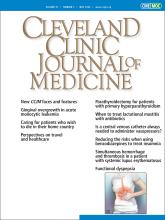A 60-year-old woman who is otherwise healthy is found to have an elevated serum calcium level of 10.5 mg/dL (reference range 8.5–10.2) during her yearly checkup. Her main complaints are memory loss and fatigue, but she denies prior fractures or kidney stones. Review of her medical record shows that her calcium levels have been persistently elevated for at least the past 5 years. Additional workup demonstrates a parathyroid hormone level (PTH) of 55 pg/mL (15–65), 25-hydroxyvitamin D level of 40 ng/mL (31–80), and 24-hour urine calcium excretion of 240 mg (100–300). She has known osteopenia, with a T-score of −2.4 at the femoral neck. Her serum creatinine level is normal. Should this patient be referred for parathyroidectomy?
In patients with primary hyperparathyroidism, the decision to refer for surgery should be individualized and not based solely on whether the patient meets guideline criteria. The first question that must be addressed then is whether our patient has primary hyperparathyroidism.
She has hypercalcemia (serum level of 10.5 mg/dL) with a replete 25-vitamin D level, and although her PTH level at greater than 30 pg/mL is within the normal range, it is still inappropriately high, confirming the diagnosis of primary hyperparathyroidism. Traditionally, the diagnosis of primary hyperparathyroidism was made based on concomitant calcium and PTH levels above the normal limits, but we now recognize that what matters is the relationship of the levels rather than the absolute values.1
Also, although the diagnosis is clear in this patient with hypercalcemia and an inappropriately high PTH, familial hypocalciuric hypercalcemia should be considered in the differential. Familial hypocalciuric hypercalcemia, though far less common than primary hyperparathyroidism, presents with similar biochemical patterns, except for hypocalciuria (< 100 mg/24 hours). The urine calcium:creatinine clearance ratio may help distinguish between the 2 conditions.2
The next question—should our patient be referred for parathyroidectomy?—is more complex. According to current international consensus guidelines, she does not meet the criteria for surgery because her serum calcium is not 1.0 mg/dL above the upper limit of normal, she is older than 50, and she does not have osteoporosis, nephrolithiasis, fractures, decreased creatinine clearance, or hypercalciuria (Table 1).2 The decision to treat, however, should not rely solely on whether the patient meets guideline criteria. Surgery can improve bone health, reduce the likelihood of nephrolithiasis or even chronic kidney disease, and improve serum calcium values. Also, several neuropsychiatric symptoms are likely to improve with surgery, such as fatigue and brain fog.1
International criteria for parathyroid surgery in patients with primary hyperparathyroidism
INDIVIDUALIZING THE DECISION TO TREAT
Research indicates that the level of hypercalcemia does not correlate with the presence of symptoms.3 Thus, our patient may still be prone to symptoms attributable to primary hyperparathyroidism with her calcium level of 10.5 mg/dL. Her age also may not be relevant and should be seen as being part of a continuum rather than a specific cutoff point. Given current life-expectancy estimates, patients older than age 50 can still be at risk for additional long-term manifestations of the disease. In fact, parathyroidectomy is the most cost-effective strategy for patients with at least 3 years of life expectancy based on fracture risk reduction.4
Related to bone health, while our patient does not meet the bone mineral density criterion (T-score ≤ −2.5) for surgery, the T-score also should be seen as a continuum. She likely will progress and eventually meet the criterion, as untreated primary hyperparathyroidism can cause significant bone loss.5 Parathyroidectomy can improve bone mineral density and reduce the risk of fractures.5,6
Finally, our patient presented with neurocognitive symptoms that included memory loss and fatigue. Though still a matter of debate, there is growing evidence that these symptoms and quality of life can improve after parathyroidectomy.1,7,8
Careful evaluation of this patient indicates she would benefit from consultation with a high-volume parathyroid surgeon.
THE BOTTOM LINE
Primary hyperparathyroidism is frequently underrecognized and underdiagnosed. It is the most common cause of hypercalcemia in the outpatient setting.9 While consensus guidelines may be useful in large population studies, individualizing care is most important. Surgical correction can result in improvements in health and quality of life. It is essential to recognize hypercalcemia with nonsuppressed PTH values and to individualize treatment for each patient even when the exact surgical criteria are not met. In patients presenting at a young age or with strong family history, hereditary endocrinopathies must be considered.
DISCLOSURES
The authors report no relevant financial relationships which, in the context of their contributions, could be perceived as a potential conflict of interest.
- Copyright © 2024 The Cleveland Clinic Foundation. All Rights Reserved.






